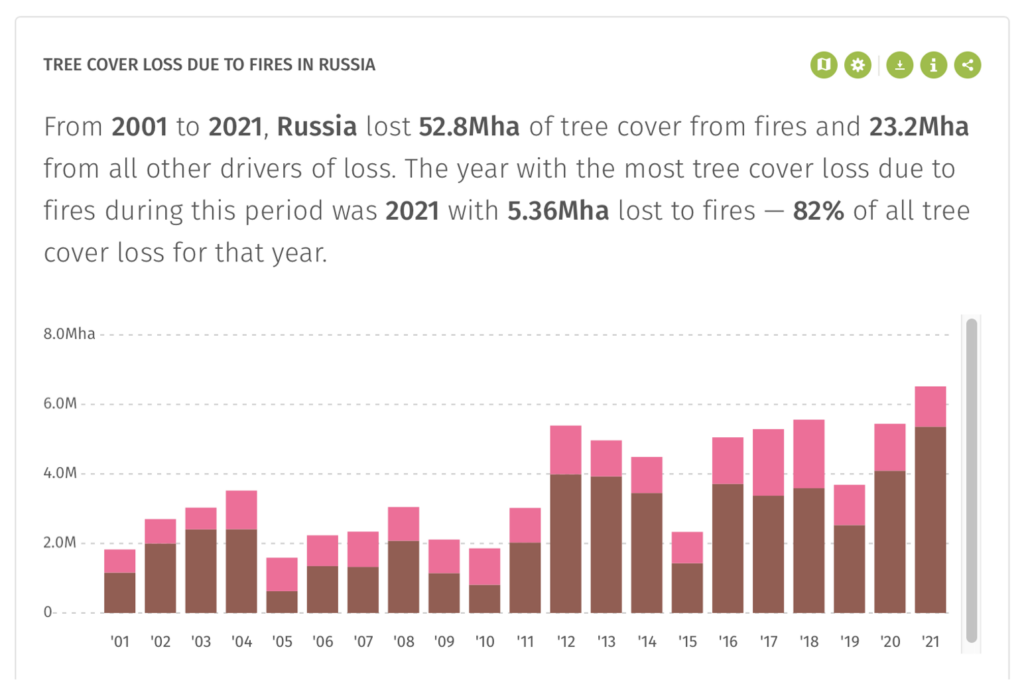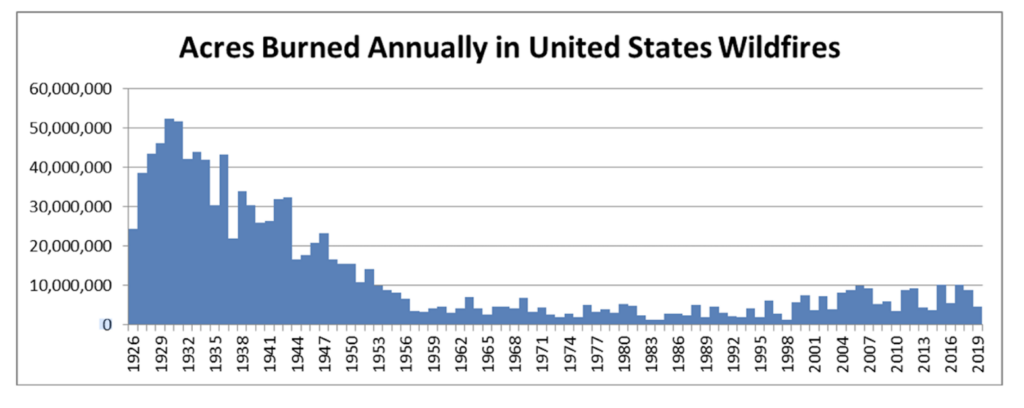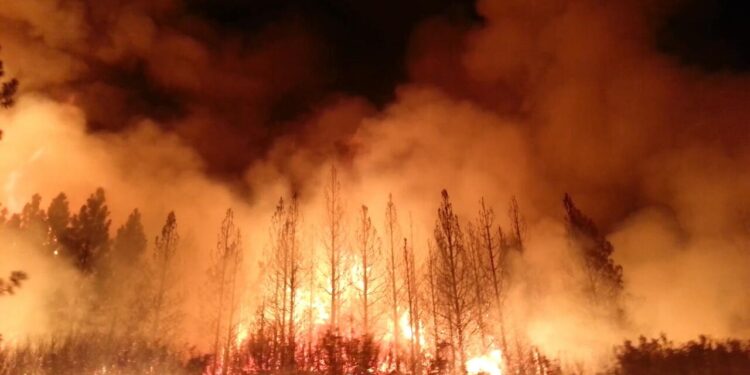Last Wednesday, Matt McGrath reported on the BBC that the amount of tree cover being burned has nearly doubled over the past 20 years. Of the 9.3 million hectares burnt globally, Russia was alleged to account for more than a half. Of course, climate change was said to be a “key factor” in the increase. There is no factual basis for this claim, needless to say. Take the word of Greenpeace, which recently reported Russian government statistics that showed “nine out of ten wildfires in the country were caused by humans”.
McGrath, of course, was complying with the Corporation’s strictly-enforced agenda that says that almost every natural disaster and episode of extreme weather should be blamed on humans burning fossil fuel. The ultimate political agenda is the command-and-control Net Zero fantasy. Climate change was said to be the key factor by McGrath because it leads to higher temperatures and drier conditions. Except, it might be added, when global temperatures pause, as they have throughout most of the 21st century, and droughts turn into floods, etc., etc.
The data on tree loss comes from Global Forest Watch (GFW), which uses information taken from orbiting satellites. Last year was said to be the second worst year on record. “It’s roughly twice what it was just 20 years ago. It is kind of astonishing just how much fire activity has increased over such a short amount of time,” said James MacCarthy, an analyst with GFW.
The data used by GFW is taken from a number of Landstat satellites and processed by the Global Land Analysis and Discovery (GLAD) laboratory at the University of Maryland. But the GLAD data comes with a number of important warnings and caveats. The first satellites used in the 20-year record provided less data and there are gaps in the record. There was improved performance from 2012, but GLAD warned that “such changes in the mapping method can result in year-to-year inconsistencies”. Additionally, “models have been iterated to improve performance in the 2012-forward period”. Care must be taken when comparing change across any interval, it cautioned.

Above is the Russian graph on tree cover fire loss taken from GFW. It can be seen that the higher annual amounts started around the same time that improved satellite data came on stream. The past results going back to 2001 were flat for a decade, then different reporting and modelling came in, and they have been flat ever since, but at a higher level. Climate change is not the most obvious and rational reason to explain this ‘trend’.
Far from global fire losses being “staggering” over the last 20 years, as faithfully reported by McGrath and the BBC, it’s possible they have changed little in that period. That was the opinion of the Royal Society in October 2020 when it noted that there had been no overall increase in total area burnt by fire across the globe. In 2016, two academics from Swansea University, Professor of Wildfire Stefan Doerr and Dr Christina Santin, published a ground-breaking paper in which they disclosed that the global area burned “appears to have declined over past decades”. In fact, they noted, there was “increasing evidence that there is less fire in the global landscape than centuries ago”.
The academics went on to note that fire has been an important factor in the dynamics of the Earth’s climate and in the development of biomass since its widespread occurrence began 400-350 million years ago. They suggest fire suppression and alarm has arisen from focussing exclusively on first in the West by advocacy groups in the USA, Australia and Mediterranean Europe. They conclude that the attempt to bring all fire under control is “long proven to be impractical, unsustainable and ecologically detrimental in fire-prone reasons”.
The biblical catastrophising of fire is rampant throughout mainstream media. Most fires are caused by humans, whether accidentally or on purpose. For instance, in 2011 a research project funded by the Forestry Commission discovered that over 90% of South Wales grassland fires were recorded within 100 metres of a road or public right of way. The figure climbed to 99% if you extended the distance to 500m. But climate change is the only game in town these days. It seems nothing must get in the way of that narrative.

The graph above shows that U.S. wildfires were much worse in the past. Dramatic improvements have been recorded since the 1930s. Last year the National Interagency Fire Center suddenly removed all the collations prior to 1983, stating that “there is no official data prior to 1983 posted on this site”. Of course, 1983 is a convenient low point, meaning that the media can now faithfully report that wildfires have been increasing in the U.S.
The American meteorologist and climate writer Anthony Watts is less than impressed: “This wholesale erasure of important public data stinks, but in today’s narrative control culture that wants to rid us of anything that might be inconvenient or doesn’t fit the ‘woke’ narrative, it isn’t surprising.”
Chris Morrison is the Daily Sceptic’s Environment Editor.
Postscript: One of the claims in this article – that there are fewer forest fires today in the U.S. than there were in the first part of the 20th Century – has been challenged by Dave Vetter, a “Sustainability Senior Contributor” to Forbes. Chris has replied to his criticisms here.












To join in with the discussion please make a donation to The Daily Sceptic.
Profanity and abuse will be removed and may lead to a permanent ban.
I’m starting to think that forest fires are a lot like mass coral bleaching events.
Both have always happened, and always will regardless of whether average temperatures go up or down in the future. The initial impact of both events look catastrophic and so make good climate doom porn/clickbait. As daily sceptic highlighted earlier this month coral recovers quickly from bleaching, and I bet vegetation recovers almost as quickly from a lot of fires, although this is obviously something the MSM won’t report.
Agreed. What they’re doing is reporting normal, natural events as something abnormal. They did the same with COVID-19 acting as if it was wildly different from any other virus.
Until the early 1990s, it was common practice to burn stubble on certain fields. It was banned after 1993 ( https://api.parliament.uk/historic-hansard/commons/1989/nov/30/straw-and-stubble-burning ).
No one mentions the issue of the large areas of public land that are no longer being attended to for alleged environmental reasons. In cities, there are now large areas of public grassland in the suburbs that haven’t been cut. There’s a sign claiming it’s to do with nature groups in one of them near us. I’ve been told that the weeds are ‘good for insects’ (to make up for the billions chopped up by wind turbines?) What this leads to is scruffy-looking public land that is now has hip-deep grass, is overrun with weeds and, after a few weeks of sunshine, is dry as a bone, brown and full of dried leaves that have fallen from trees. This land is a tinderbox waiting for a dropped Zippo lighter.
For centuries, people understood that you attended to these areas and kept weed and grass grown down to prevent fires. Controlled burn backs were the norm. In the last 30 years, centuries of hard-learned good practice has been ditched to get Twitter likes from a bunch of sexually-deviant, purple-haired loons who think they know more about looking after the planet than the sum knowledge of land management accumulated by our ancestors, who knew what it was to lose homes and family members and incomes to fires.
Ditto, the people who end up with houses flooded to four feet deep because the Environment Agency wont dredge rivers for fear of upsetting a newt or two.
All these Environmental Impact Studies that get done. None of them seem to allow for what happens to people and property, its always the rare and ‘must be preserved’ lesser spotted Arse Beetle that takes precedence.
What seems to be being lost in the weeds here is the existence of the carbon cycle. Trees are plants, which photosynthesise, They get their carbon from the CO2 in the atmosphere, so there is no net addition to CO2 levels in the air (if that actually matters anyway) when they burn.
Amazingly enough some people may notice that plants regrow on the burned ground, so re-sequestering the carbon released in quite a short period of time.
I don’t understand what all the fuss is about, and why this isn’t pointed out more often.
Which is the logic behind arguing that burning wood chipping at Drax power station is essentially neutral, ignoring the fuel burned by shipping across the Atlantic, diesel locomotives etc. In some areas it seems reasonable to encourage a range of wild flowers etc to feed the bees and so on.
Poor forest management is mainly to blame for many fires these days. Firebreaks are often left uncleaned….with fallen trees and long scrub between sections. I’m not far from Thetford Forest and it’s plain to see how easily a fire could spread.
We all warned after Covid (if that is over) that climate change was the next battle…so the first real skirmishes have begun in earnest. Lets hope they don’t cancel scientist who dissent thus creating a ‘consensus’……oh wait, they already are!
–
–
–
If you guys want to hear our latest podcast, then check it out and subscribe below:
Ep. 51 BANNED FROM TWITTER (Find out why)
We’ve been banned from Twitter for a week…find out why! Plus we talk Canada and Justin Trudeau, your first ‘Listener Rant’, Climate change madness, University PHD’s gone mad, Scotland’s gone crazy, The return of the Big Breakfast and MUCH MORE!
https://therealnormalpodcast.buzzsprout.com/1268768/11142910-ep-51-banned-from-twitter-find-out-why